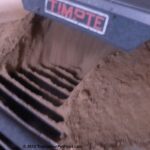Improper cooling practices are a significant contributor to foodborne illnesses. It’s crucial to understand why and how to cool food rapidly and safely to prevent bacterial growth and ensure food safety.
Michigan State University Extension frequently receives inquiries about the proper methods for cooling cooked foods. This highlights a common concern among home cooks and food handlers alike.
Why is rapid cooling so important? The answer lies in the temperature danger zone.
The Danger Zone: A Breeding Ground for Bacteria
The temperature danger zone, ranging from 41°F to 140°F (5°C to 60°C), is the optimal temperature range for bacterial growth. When food remains within this zone for extended periods, bacteria multiply rapidly, increasing the risk of food poisoning. Cooling hot food slowly allows it to linger in this danger zone, creating a hazardous environment.
Think of it this way: bacteria are like party guests; they thrive in warm environments with plenty of “food” (nutrients). Quickly cooling food denies them the opportunity to multiply and spoil your culinary creation.
Consequences of Slow Cooling: A Recipe for Disaster
Imagine preparing a large batch of chili. You let it sit on the stovetop to cool for several hours before refrigerating it. During this time, the chili slowly descends through the danger zone, providing ample opportunity for bacteria like Clostridium perfringens and Bacillus cereus to flourish. These bacteria can produce toxins that cause diarrhea, vomiting, and abdominal cramps. Even reheating the chili may not eliminate these toxins, leaving you with a foodborne illness.
Safe Cooling Strategies: A Step-by-Step Guide
Fortunately, rapid cooling is achievable with the right techniques. Here’s a comprehensive guide:
- Divide and Conquer: Transfer hot food from large pots or containers into smaller, shallower containers. This increases the surface area exposed to cooling, accelerating the process. Cutting large pieces of meat or poultry into smaller portions also helps.
- Ice Bath Immersion: Create an ice water bath by filling a large bowl or sink with ice and a small amount of water. Place the containers of hot food into the ice bath, ensuring the water level reaches near the top of the container without spilling over. Stir the food frequently to promote even cooling.
- The Stainless Steel Advantage: Opt for stainless steel containers over plastic. Stainless steel conducts heat more efficiently, facilitating faster cooling.
- Strategic Additions: For soups, stews, and other liquid-based dishes, consider adding ice or frozen ingredients (like vegetables) to expedite the cooling process. However, ensure that the additions don’t compromise the flavor or texture of the dish.
- Refrigerator Readiness: Once the food has cooled sufficiently (no longer steaming), loosely cover it before refrigerating. This allows for further heat dissipation. Once completely cooled, seal the container tightly.
Time is of the Essence: The Two-Hour Rule
The golden rule of food safety is the two-hour rule. Perishable foods should be cooled from 140°F (60°C) to 70°F (21°C) within two hours and then from 70°F (21°C) to 41°F (5°C) or lower within an additional four hours. If food remains in the temperature danger zone for more than two hours, it’s best to discard it.
Real-World Example: Soup Safety
Consider the example mentioned earlier, where a person prepared four quarts of soup and added frozen zucchini before refrigerating it overnight. The soup remained warm even after refrigeration. This scenario highlights the dangers of inadequate cooling. The soup should have been discarded due to the risk of bacterial contamination. The addition of frozen zucchini was insufficient to rapidly cool the soup to a safe temperature.
Prioritizing Food Safety: A Proactive Approach
Cooling food quickly and safely is not just a suggestion; it’s a necessity for preventing foodborne illnesses. By understanding the principles of rapid cooling and implementing the strategies outlined above, you can protect yourself and your loved ones from the dangers of bacterial contamination and enjoy your meals with peace of mind.
Take the time to cool food within two hours and refrigerate or freeze it promptly. Your health and well-being are worth it.

